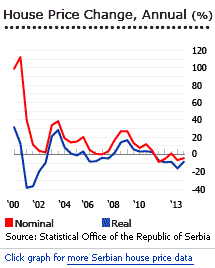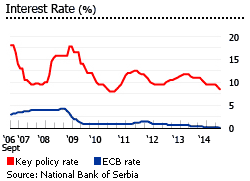Serbia under new leadership

Few people in Serbia would put property prices at the top of their list of worries, though house prices were down by 4.1% (-8.1% in real terms) on the year, according to the Statistical Office of the Republic of Serbia.
Economic and political issues are much bigger worries in this country, which has still not fully emerged from the bad old days.
Serbia still has massive unemployment (21%), a very low standard of living (average net salary EU 383/month), massive corruption, and an economy in large part stuck in the Communist era. Over the past 5 years there has been zero economic growth, though Serbia's economy grew by 2.5% in 2013, according to the National Bank of Serbia.
Little economic growth is expected in 2014.
So that's why the general mood is despondent: dwelling permits for new residential construction fell 7.6% in 2013, according to the Statistical Office of the Republic of Serbia, while permits in Belgrade fell by almost 22%.
Serbia's new Prime Minister, Aleksandar Vučić, elected in April 2014, is undoubtedly the most popular Serbian leader since Slobodan Milosevic. He is an ex-extremist with two faces: a strident nationalist for home consumption, and a penitent reformer when speaking to the EU. His ruling Serbian Progressive Party (SNS) won the March 2014 elections by a landslide 48.35% of votes, so he is a very powerful man.
Vučić understands that some shibboleths of Serb nationalism must be let go. Kosovo must be allowed to become an independent state. He is also big on pushing for the reforms necessary to secure EU membership, big on budget control, and big on reducing corruption.
However, he is also somewhat erratic, a populist, and an authoritarian.
Sadly, Serbia is a country which has not come to terms with itself. In answer a recent survey response to the question "When was the best [time] in Serbia?" 78% of respondents replied "between the end of WW2 and 1990"-the year the Federal Republic of Yugoslavia began to break up. When asked, "How much of the responsibility for the wars of the 1990s lies with the peoples of former Yugoslavia, and how much with the international community?" around 75% said the wars were partly or entirely the fault of the international community.
There is also enormous distrust of all domestic institutions. Only 15% of those questioned in the survey, run by Center for Free Elections and Democracy (CeSID), believed that Milosevic's fall was "the beginning of the democratic transformation of Serbia." Nearly half said, "Everything remains the same, only one set replaced the other."
However, Serbia has at least three things going for it.
First, Serbia is extremely low cost, attracting western manufacturers like Fiat, which has been expanding its Serbian operation, which in just over two years has gone from zero to becoming the country's largest exporter. It now employs over 4,000 workers in Kragujevac, a town in central Serbia, and has invested €1.2 billion in the plant, which now turns out 600 of the company's chunky, family-friendly 500L small cars each day.
Second, inflation is now under control. Hyperinflation, in the strict sense of the word, ended in 1995 when Serbia adopted the Deutschemark as an official currency alongside the dinar. This May, inflation was only 2.1% per annum (however, Serbia's trade unions are restive).
Finally, Vučić campaigned on the basis of EU membership, and the EU has decided that EU membership could moderate Serbian nationalism. The government aims to complete accession talks by the end of its term in 2018. Serbia is therefore committed to giving at least the appearance of reforms in all fields -the rule of law, interior affairs and protection of human and minority rights.
This will likely be appearance only. Finance minister Lazar Krstic has just resigned in protest at government profligacy, nationalist posturing is everywhere, and press censorship is also on the increase.
Serbia has changed less from communist days than other transition states. So there is a long, long way to travel.
Tumultuous times
After the dissolution of Yugoslavia in the early 1990s, Serbia (with Montenegro until 2006) went through a tumultuous decade, including a major civil war during 1991-2000. Hyperinflation ravaged the economy. Housing construction declined to 10,000 units per year from 1995 to 2000, from 50,000 dwellings annually between 1960 and 1985.
Between 1991 and 2000, most dwelling units were privatized. Public rental units were sold to sitting tenants at below-market prices, based on current average monthly wages.
Prices rose between October 1993 and January 1995 by 5 quadrillion percent (5 with 15 zeroes after it), but wages (on which privatized house sales prices were based) were pegged to pre-inflation levels, so households were able to buy their houses for next to nothing.
Privately owned housing increased to 92% of the total stock in 2002 (88% owner-occupied and 6% occupied by relatives) from 77% in 1990. Only 7% of the housing stock in 2002 was rental units, 4.9% of which was private, and 2.1% publicly-owned rental units.
Most real estate transactions are now paid in cash, and the economy is highly euro-ized.
Rental yields are moderate to high
Belgrade, Serbia's capital, is not an expensive city, with average new dwelling prices of RSD 166,497 (US$ 1,961) per square metre (sq. m.). Novi Sad average prices are at RSD 106,053 (US$ 1,249) per sq. m., and Kragujevac RSD 110,448 (US$ 1,301) per sq. m.
Serbia's rental market has moderate to high rental yields, according to Global Property Guide Research of March 2013.
In contrast to other districts in Belgrade, rental yields in the most expensive district, Savski Venac improved. Yields range from 5.57% to 7.20%, with smaller apartments mostly having higher yields. Yields have improved from 2012.
Aside from Savski Venac, the best yields in Belgrade can also be found in Novi Beograd, where yields range from 5.91% to 6.32%.
In other areas in Belgrade:
- Apartments in Vracar had the third highest average yield, ranging from 4.68% to 5.36%.
- Zvezdara and Vozdovac's apartments have moderate yields from 4.64% to 5.22%.
- Stari Grad had the lowest average yield, ranging from 4.44% to 4.97%.
Demand remained stable in Q1 2014, according to CBRE. Rents for renovated properties typically range from €8 (US$ 11) to €10 (US$ 14) per sq. m., while rents for newly built properties were at around €10 (US$ 14) to €13 (US$ 18) per sq. m. although some units generate rents of up to €15 (US$ 20) per sq. m. depending on the apartment's quality and location.
When it comes to renovated properties, New Belgrade had the lowest asking rents, ranging from €6 to €8 per sq. m., followed by Downtown with rents at around €7 to €10 per sq. m. Dedinje and Vracar both have asking rents ranging from €8 to €10 per sq. m.
For newly built properties, Downtown had the widest range of asking rents from €8 to €15 per sq. m. In New Belgrade rents range from €9 to €12. Rents are even higher in Vracar (€10-€13) and Dedinje (€10-€14).
Declining mortgage growth
In 2013 there was only 3.2% mortgage loan growth, after 23.6% growth in 2010, followed by single digit growth rates in 2011 (5.4%) and in 2012 (8.5%). Outstanding loans to households in Serbia expanded by more than 50% annually from 2001 to 2007, to 13.4% of GDP in 2007.

Construction activity is falling
The Serbian residential market has been active over the past decade, with continued construction activity in Serbia's three largest cities: Belgrade, Nis, and Novi Sad.

From around 13,871 dwellings in 2003, housing completions rose by 42.9% to a peak of 19,815 units in 2008. The increase was mainly driven by the government's creation of the National Corporation for Housing Loans.
However, the post-2009 recession cut completions to around 15,223 units in 2012.
In 2012, residential housing demand fell due to tighter loan conditions and lower purchasing power. There were many repossessions: "The risk of taking a mortgage loan in Serbia is showed by the fact that banks offered more than 250 apartments on sale in Belgrade area only," says Danos Serbia. Belgrade itself however had the most newly constructed units for the past 15 years, at 8,096, 53.2% of all completions in Serbia 2012, with several projects entering their final construction phase. Dwelling permits issued in Belgrade rose by 4.1% in 2012.
In 2013 housing demand again fell slightly, because the borrowers' participation ín loans was increased to 10%, from 5%, despite the government allocating € 15 million (US$ 20 million) for housing loan subsidies.
In 2014 lower demand is expected to continue, as the Serbian government this year abolished subsidized housing loans, due to the government's financial problems. Despite that, the Ministry of Finance assured citizens who had sent requests for housing subsidized loans by December 10, 2013, that they would be considered for subsidies.
However interest rates are falling

In June 2014, the National Bank of Serbia decided to cut its key policy rate to 8.5% from its previous rate of 9% - the second rate cut in 2014. That's because as of May 2014, Serbia's y-o-y inflation rate was 2.1%.
From 2002 to 2009, the country reduced inflation to an average of 9.9% per year.
Since most loans are denominated in euro, the interest rate cuts recently implemented by the European Central Bank (ECB) are expected to aid loan growth. In its most recent move, the ECB cut its base rate to an all time low of 0.15%.
Little growth is expected in 2014
Serbia's economy grew by 2.5% in 2013, after a recession in 2012 (-1.5%). In 2011 growth was 1.6% and in 2010 1%, after a 3.5% GDP contraction in 2009.
During the first quarter of 2014, economic activity actually fell by 0.3%. The Ministry of Finance expects growth of from 0% to 0.5% GDP contraction in 2014, partly depressed by the aftermath of the destructive floods that occurred last May.
Serbia's unemployment was 20.8% during the first quarter of 2014.
The public deficit in 2014 is likely to be around 4.6% of GDP at RSD 183 billion (US$ 2.2 billion), slightly lower than 4.7% in 2013. The 2014 austerity plan includes reductions in subsidies and public administration costs, a tax raise, and a higher retirement age for women.
The Kosovo issue could still explode
The Kosovo issue still has the potential to cause a lot of damage. After Montenegro voted for independence in 2006, the Union of Serbia and Montenegro was officially dissolved - the last remnant of the former Yugoslavia, which once included Bosnia and Herzegovina, Croatia, Macedonia, Montenegro, Serbia and Slovenia.
Serbia's long history of conflict and revolutions, however, is far from over. Kosovo is currently administered by the United Nations after violence flared up in 1998. UN-sponsored talks on the status of Kosovo are continuing.
As part of the conditions for Serbia's EU candidacy, normalization talks between Serbian Prime Minister Ivica Dačić and Kosovo Prime Minister Hashim Thaçi, mediated by the European Union, started on October 19, 2012 in Brussels.
In April 19, 2014, after ten rounds of talks mediated by the EU, the two governments signed the Brussels Agreement committing both parties not to "block" or encourage others to "block" the other side's progress toward the EU.
Although Kosovo's independence is still unrecognized by Belgrade, part of the deal is that a special police commander and an appeal court will be established for the Serb minority in Kosovo.